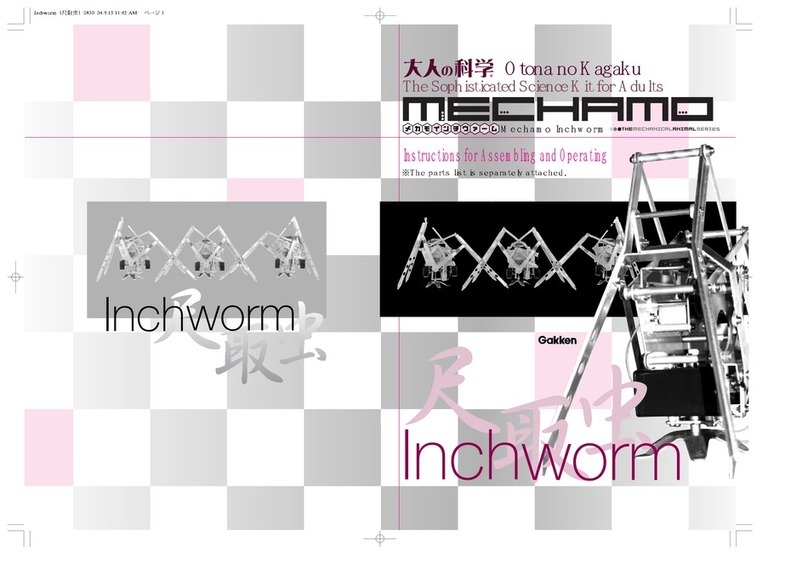32
The Stirling engine was invented by Robert Stirling (1790-1878) from Scotland, U.K who was an engineer and minister. He
invented this external combustion engine in 1816 because the steam engine, which was in its heydays then, incur casualties
repeatedly caused by the boiler explosion and he was pained at it. Around 1850, the Sterling engine was used for as many usages
as the steam engine was used for. However, since the gasoline engine is invented and diffused rapidly, the Sterling engine faded
out of the history. It is spotlighted again at the oil crisis in1973. It attracts attention because of the high theoretical value of
thermal efficiency and also because this external combustion engine has no limitation of heat source. As further research has
done, it is aimed to be used practically in various fields such as usage in space with solar energy and so forth.
Enjoy assembling and experiment to understand the basics of thermodynamics. You can try three kinds of experiments, namely,
the generator, the fan, and the car.
It takes about three hours to assemble. You don't need any special tool. (Size AA batteries to adjust the engine and alcohol fuel
are not included in the kit.) Please follow this instruction booklet when you assemble.
Warning ★ Fire is used for the experiment. Use great caution to avoid a burn and fire.
Do not let a 15 or less-year-old child experiment alone.
● The plastic materials used in this kit ●
gear (black) : POM piston cover, bearings, gauge (black) : ABS resin battery box (black) : polypropylene
screwdriver handle : polyethylene small bags : polyethylene
● The metallic materials used in this kit ●
main body parts and stand : aluminum displacer: iron pipes : brass flywheel and regenerator: copper
screws : nickel-plated iron
*Vinyl chloride resin is used for the covers of the lead wires.
*disposing of the kit, please follow the recycling regulations in your area.
CAUTION! ★Please read the following instructions before using this kit.
● Use this kit for the original purpose only.
● Use caution when handling the glass cylinder. A piece of broken glass may cause injury.
● Fire is used for the experiment. Use great caution against a burn and fire.
● To avoid danger of a burn, never touch the glass cylinder while the engine is running.
● The glass cylinder remains hot for a while after the experiment. Do not touch it to avoid danger of a burn.
When touching, make sure it gets cold enough.
● Use caution when handling any metallic parts. Improper use may cause injury.
● To avoid danger of suffocation, do not swallow small parts such as screws.
● To avoid danger of injury, do not point your hands and eyes with the screwdriver and the like in this kit.
● To avoid danger of traffic accident, do not operate the machine on the road.
● To avoid danger of electric shock, do not insert lead wires into an electric socket.
★ Please read the assembly instructions and cautions in this booklet carefully before using this kit.
Do not use any materials that have become damaged or deformed while in use.
★ Keep the kit away from small children when not using.
Contents and Cautions ………………2
Stirling Engine…………………………3
Before Assembling the Kit ………… 4
1. Assembling the Stand …………… 5
2. Attaching Wheels to the Body……7
3. Attaching the Cylinder to the Body
………………………8
4. Assembling the Lever Part………10
5. Assembling the Piston Part …… 11
CONTENTS
Warning ★ Fire is used for the experiment. Use great caution to avoid a burn and
fire. Do not let a 15 or less-year-old child experiment alone.
Two size AA batteries are required. Improper use of the batteries may cause the generation of heat, explosions or leaks. The following
precautions should be taken:
● Do not use rechargeable batteries, such as nickel cadmium batteries, and oxyride batteries.
● Ensure that the positive and negative terminals on the batteries are facing the right way.
● Do not use used batteries and new batteries together and do not mingle more than two kinds of batteries.
● Do not short-circuit, recharge, break up or put the batteries in a fire.
● Remove the batteries when not using for a long time.
6. Attaching the Safety Covers………16
7. Starting the Engine with the Alcohol
lamp …………………………………19
8. Making Experiments of the
Generator, the Fan and the Car … 20
Trouble Shooting Stirling Engine……22
Attaching Non-Slip Cover
to the Four Corners of the Stand
& Making Your Own Displacer… 23




























